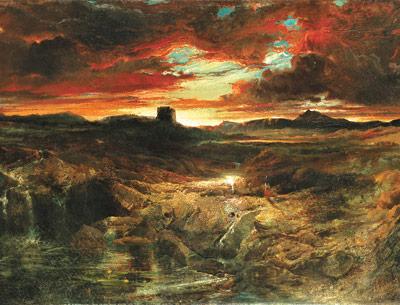Tracing Moran, Maiwald’s Embroidery

Guild Hall will open two exhibitions this week to inaugurate the museum’s fall season, each lively and provocative in its own way. In one gallery, Thomas Moran’s stylistic legacy and his preoccupation with European art movements will be examined in “Tracing Moran’s Romanticism and Symbolism.” In the other, Christa Maiwald will offer “Short Stories and Other Embroideries.” Ms. Maiwald was the winner of the 2011 members exhibition.
The Moran exhibition was organized by Phyllis Braff to draw attention to the museum’s acquisitions both recent and longstanding and an extended loan by one collector. The show also features some other significant loans, including an 1884 painting from the National Gallery of Art in Washington, D.C.
Phyllis Braff, the curator and a co-editor of the Moran catalogue raisonne, organized the show with an eye to putting the artist within the greater context of what was happening in both America and Europe at the time he was painting.
“He was addicted to America in his content, but used the stylistic tradition of European masters, using glazes, under-painting, and charcoal undertones” to express himself, she said last week. “He was never a plein air painter.”
Indeed the stories that emanate from the Studio, his residence and working space on Main Street overlooking Town Pond, center on him taking sketches he made out West and translating them to canvas. “He used sketches as references and changed and adapted the views selectively,” co-opting landscape traditions established over centuries by Nicolas Poussin, Claude Lorrain, and J.M.W. Turner, Ms. Braff said.
While not a strict Romanticist and certainly working years apart from them, he shared some of the same sensibilities in his earlier works, such as “Childe Roland to the Dark Tower Came” from 1859, which cribs from the poet Robert Browning cribbing from Shakespeare’s “King Lear.” In 1862 he revisited a Turner subject taken from Homer’s “Odyssey” in “Ulysses Deriding Polythemus.”
In the same vein, he was not a member of the more modern “Symbolist” movement in art, but rather used symbolism the way old masters would. In 1864’s “Nutting, Autumn,” viewers will see a family gathering nuts, which he painted for the Philadelphia Sanitary Fair, a fund-raiser for the wounded from the Civil War. The peaceful scene sent the message that “soon all of the horrors of the war would be over, and families can get back to doing such activities together,” Ms. Braff said, adding that Abraham Lincoln visited the exhibition.
The National Gallery painting from 1884, “The Much Resounding Sea,” has East Hampton’s Main Beach and Homer’s “Iliad” as inspiration. Homer seems to be an enduring inspiration. Ms. Braff said Moran was much attached to his earlier “Ulysses” painting, and it hung over the mantel at his East Hampton studio from the time he built the house until his daughter Ruth Moran died and the house was sold. This is also the painting on extended loan to the museum from Ian Cumming of East Hampton.
In quite a different fashion, Ms. Maiwald’s recent embroideries tackle the zeitgeist with the famous and infamous stitched on seat cushions, lampshades, pillows, and pinafores. Each unit of a piece focuses on one person or subject, or at the most two. Yet each piece gains its potency and heft from the assemblage of those multiples set out in installations such as “Servitude,” representing famous tyrannical bosses such as Gordon Ramsey and actual tyrants such as Imelda Marcos as needlework portraits on miniaturized maids’ uniforms mounted over lamps.
In “Musical Chairs: Economic Crisis in G Minor” from 2009, various bad actors and regulators from the financial meltdown of 2007-8 are depicted in brightly colored seat cushions, the musical chairs theme and installation implying the fluidity with which some of these figures moved from the industry that created the problems into the regulatory arena that was charged with solving them.
“Garden Party” from 2007 is another lamp installation with found children’s dresses serving as the support for images of dictators such as Saddam Hussein and Kim Jong-Il. On an apparently lighter note but with darker undertones in the context of the Bush presidency, are the portraits of comedians from “Laughing Stock” featuring Jim Carrey, Whoopi Goldberg, and David Letterman to name a few. Her work from this year has taken on broader themes. One series features famous artists and their creations and another, “Plant Therapy,” conflates gardening with mental health issues and disorders.
Ms. Maiwald, who lives in Springs, has been using the fiber-based medium since 2000, choosing it for its portability as well as the inherent tension that arises when edgy subject matter meets homespun charm. She has also worked in sculpture, film, photography, and installation art. She continues to work in video art as well. Guild Hall will present a gallery talk with her on Nov. 17 from 2 to 3 p.m.
An opening reception for both shows will take place on Saturday from 5 to 7 p.m. They will remain on view through Jan. 5.
